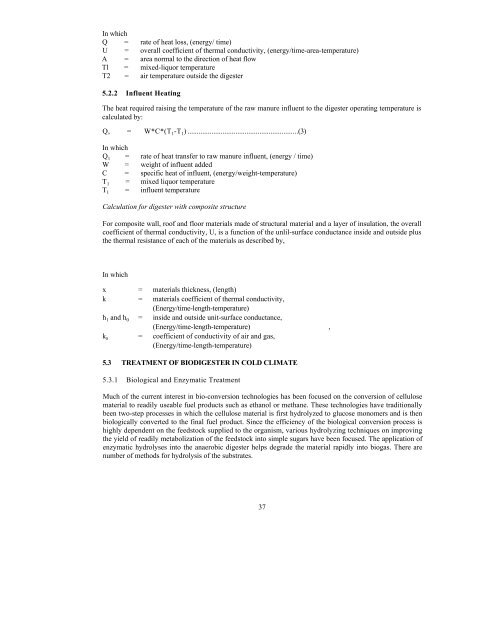download (pdf, 6MB) - SNV
download (pdf, 6MB) - SNV
download (pdf, 6MB) - SNV
Create successful ePaper yourself
Turn your PDF publications into a flip-book with our unique Google optimized e-Paper software.
In which<br />
Q = rate of heat loss, (energy/ time)<br />
U = overall coefficient of thermal conductivity, (energy/time-area-temperature)<br />
A = area normal to the direction of heat flow<br />
Tl = mixed-liquor temperature<br />
T2 = air temperature outside the digester<br />
5.2.2 Influent Heating<br />
The heat required raising the temperature of the raw manure influent to the digester operating temperature is<br />
calculated by:<br />
Q, = W*C*(T 1 -T 1 ) ............................................................(3)<br />
In which<br />
Q 1 = rate of heat transfer to raw manure influent, (energy / time)<br />
W = weight of influent added<br />
C = specific heat of influent, (energy/weight-temperature)<br />
T 1 = mixed liquor temperature<br />
T 1 = influent temperature<br />
Calculation for digester with composite structure<br />
For composite wall, roof and floor materials made of structural material and a layer of insulation, the overall<br />
coefficient of thermal conductivity, U, is a function of the unlil-surface conductance inside and outside plus<br />
the thermal resistance of each of the materials as described by,<br />
In which<br />
x = materials thickness, (length)<br />
k = materials coefficient of thermal conductivity,<br />
(Energy/time-length-temperature)<br />
h 1 and h 0 = inside and outside unit-surface conductance,<br />
(Energy/time-length-temperature) ,<br />
k a = coefficient of conductivity of air and gas,<br />
(Energy/time-length-temperature)<br />
5.3 TREATMENT OF BIODIGESTER IN COLD CLIMATE<br />
5.3.1 Biological and Enzymatic Treatment<br />
Much of the current interest in bio-conversion technologies has been focused on the conversion of cellulose<br />
material to readily useable fuel products such as ethanol or methane. These technologies have traditionally<br />
been two-step processes in which the cellulose material is first hydrolyzed to glucose monomers and is then<br />
biologically converted to the final fuel product. Since the efficiency of the biological conversion process is<br />
highly dependent on the feedstock supplied to the organism, various hydrolyzing techniques on improving<br />
the yield of readily metabolization of the feedstock into simple sugars have been focused. The application of<br />
enzymatic hydrolyses into the anaerobic digester helps degrade the material rapidly into biogas. There are<br />
number of methods for hydrolysis of the substrates.<br />
37
















